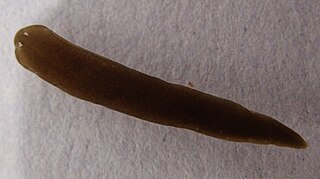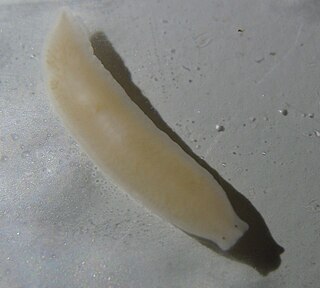
A planarian is one of many flatworms of the traditional class Turbellaria. It usually describes free-living flatworms of the order Tricladida (triclads), although this common name is also used for a wide number of free-living platyhelminthes. Planaria are common to many parts of the world, living in both saltwater and freshwater ponds and rivers. Some species are terrestrial and are found under logs, in or on the soil, and on plants in humid areas.

Planaria is a genus of planarians in the family Planariidae. When an individual is cut into pieces, each piece has the ability to regenerate into a fully formed individual.

Dugesia is a genus of dugesiid triclads that contains some common representatives of the class Turbellaria. These common flatworms are found in freshwater habitats of Africa, Eurasia, and Australia. Dugesia is best known to non-specialists because of its regeneration capacities.

Geoplanidae is a family of flatworms known commonly as land planarians or land flatworms.

Dugesiidae is a family of freshwater planarians distributed worldwide. The type genus is Dugesia Girard, 1850.

Girardia is a genus of freshwater planarians belonging to the family Dugesiidae.

Maricola is a suborder of triclad flatworms including species that mainly inhabit salt water environments. However, some species are also known from freshwater or brackish waters.
Dugesia tubqalis is a species of dugesiid triclad that inhabits springs of Morocco. It is named after the Toubkal peak, the highest in the Atlas Mountains. It has been found between 1,702 and 2,164 m of altitude.
Dugesia sicula is a species of dugesiid triclad that lives in freshwater bodies of the Mediterranean Basin, where it is widely distributed. It has been reported from Sicily, Elba and Mallorca, Eivissa, Sardinia, Algeria, Tunisia, Morocco and Crete.

Kenkiidae is a family of freshwater triclads. Their species can be found sporadically in caves, groundwater, and deep lakes in Central Asia, Far East and North America.

Schmidtea polychroa is a species of freshwater flatworm, a dugesiid triclad that inhabits the shallow mesotrophic or eutrophic waters of rivers and lakes of Europe. It is also present in North America, where it has been introduced at least in the Saint Lawrence river system. It is an animal with a limited dispersion capability.
Cura is a genus of freshwater flatworm (triclad)s belonging to the family Dugesiidae.

Dimarcusidae is a family of triclads found mostly in freshwater habitats of caves, although at least one species, Rhodax evelinae, occurs in surface waters. It is the only family within the suborder Cavernicola. Currently the family contains only seven species distributed in five genera, although the total number of species is thought to be much higher.
Neppia is a genus of dugesiid triclad that is found in South America, Subantarctic region, Africa, Tasmania and New Zealand.
Girardia dorotocephala is a species of dugesiid triclad native to North America. It has been accidentally introduced in Japan. Girardia dorotocephala is cannibalistic, which led to its usage in memory transfer experiments.

Dugesia artesiana is a species of dugesiid triclad found in Queensland, Australia.

Dugesia subtentaculata is a species of planarian that inhabits the freshwater of Southern France, several localities on the Iberian Peninsula, Mallorca, Morocco and Algeria.
Robert Edward Ogren was an American zoologist.

Dendrocoelum lacteum is a freshwater planarian found in lakes and running waters in Europe, being the most widespread freshwater planarian in this continent.

Roman Kenk was a Slovenian zoologist.











